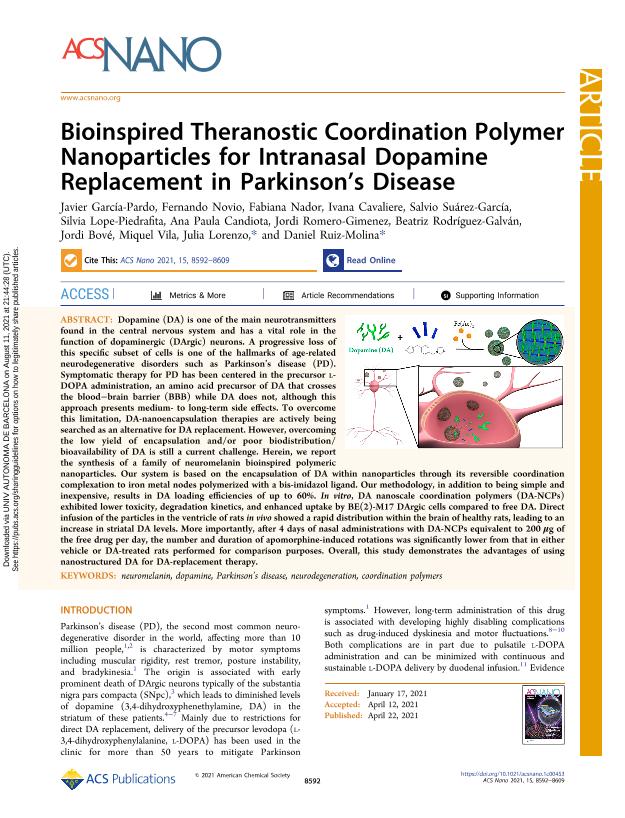Artículo
Bioinspired theranostic coordination polymer nanoparticles for intranasal dopamine replacement in parkinson's disease
García Pardo, Javier; Novio, Fernando; Nador, Fabiana Gabriela ; Cavaliere, Ivana; Suárez García, Salvio; Lope Piedrafita, Silvia; Candiota, Ana Paula; Romero Gimenez, Jordi; Rodríguez Galván, Beatriz; Bové, Jordi; Vila, Miquel; Lorenzo, Julia; Ruiz Molina, Daniel
; Cavaliere, Ivana; Suárez García, Salvio; Lope Piedrafita, Silvia; Candiota, Ana Paula; Romero Gimenez, Jordi; Rodríguez Galván, Beatriz; Bové, Jordi; Vila, Miquel; Lorenzo, Julia; Ruiz Molina, Daniel
 ; Cavaliere, Ivana; Suárez García, Salvio; Lope Piedrafita, Silvia; Candiota, Ana Paula; Romero Gimenez, Jordi; Rodríguez Galván, Beatriz; Bové, Jordi; Vila, Miquel; Lorenzo, Julia; Ruiz Molina, Daniel
; Cavaliere, Ivana; Suárez García, Salvio; Lope Piedrafita, Silvia; Candiota, Ana Paula; Romero Gimenez, Jordi; Rodríguez Galván, Beatriz; Bové, Jordi; Vila, Miquel; Lorenzo, Julia; Ruiz Molina, Daniel
Fecha de publicación:
05/2021
Editorial:
American Chemical Society
Revista:
ACS Nano
ISSN:
1936-0851
Idioma:
Inglés
Tipo de recurso:
Artículo publicado
Clasificación temática:
Resumen
Dopamine (DA) is one of the main neurotransmitters found in the central nervous system and has a vital role in the function of dopaminergic (DArgic) neurons. A progressive loss of this specific subset of cells is one of the hallmarks of age-related neurodegenerative disorders such as Parkinson's disease (PD). Symptomatic therapy for PD has been centered in the precursor l-DOPA administration, an amino acid precursor of DA that crosses the blood-brain barrier (BBB) while DA does not, although this approach presents medium- to long-term side effects. To overcome this limitation, DA-nanoencapsulation therapies are actively being searched as an alternative for DA replacement. However, overcoming the low yield of encapsulation and/or poor biodistribution/bioavailability of DA is still a current challenge. Herein, we report the synthesis of a family of neuromelanin bioinspired polymeric nanoparticles. Our system is based on the encapsulation of DA within nanoparticles through its reversible coordination complexation to iron metal nodes polymerized with a bis-imidazol ligand. Our methodology, in addition to being simple and inexpensive, results in DA loading efficiencies of up to 60%. In vitro, DA nanoscale coordination polymers (DA-NCPs) exhibited lower toxicity, degradation kinetics, and enhanced uptake by BE(2)-M17 DArgic cells compared to free DA. Direct infusion of the particles in the ventricle of rats in vivo showed a rapid distribution within the brain of healthy rats, leading to an increase in striatal DA levels. More importantly, after 4 days of nasal administrations with DA-NCPs equivalent to 200 μg of the free drug per day, the number and duration of apomorphine-induced rotations was significantly lower from that in either vehicle or DA-treated rats performed for comparison purposes. Overall, this study demonstrates the advantages of using nanostructured DA for DA-replacement therapy.
Archivos asociados
Licencia
Identificadores
Colecciones
Articulos(INQUISUR)
Articulos de INST.DE QUIMICA DEL SUR
Articulos de INST.DE QUIMICA DEL SUR
Citación
García Pardo, Javier; Novio, Fernando; Nador, Fabiana Gabriela; Cavaliere, Ivana; Suárez García, Salvio; et al.; Bioinspired theranostic coordination polymer nanoparticles for intranasal dopamine replacement in parkinson's disease; American Chemical Society; ACS Nano; 15; 5; 5-2021; 8592-8609
Compartir
Altmétricas



